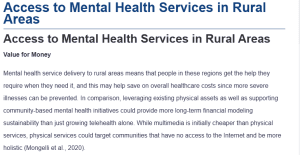Access to Mental Health Services in Rural Areas
Value for Money
Mental health service delivery to rural areas means that people in these regions get the help they require when they need it, and this may help save on overall healthcare costs since more severe illnesses can be prevented. In comparison, leveraging existing physical assets as well as supporting community-based mental health initiatives could provide more long-term financial modeling sustainability than just growing telehealth alone. While multimedia is initially cheaper than physical services, physical services could target communities that have no access to the Internet and be more holistic (Mongelli et al., 2020).
Key Stakeholders
Key stakeholders include government agencies (local, state, and federal health departments), healthcare providers (including mental health professionals and local clinics), insurance companies responsible for managing costs and reimbursements, rural communities (including patients and their families, policymakers, responsible for allocating funding and resources, and advocacy groups, which focus on rural health and mental health care access.
Differentiating Between Political Feasibility and Economic Viability
Political feasibility refers to the likelihood that a policy will be adopted and implemented, taking into account the interests and influence of various stakeholders. In the case of rural mental health, political viability could depend on political support, lobbying, and policy compatibility with contemporary government interests. For example, augmenting effective treatment available to rural individuals for mental illness might be palatable by the political agenda if it can effectively respond to critical concerns by the population on healthcare access.
On the other hand, economic viability focuses on the financial aspects, ensuring that the policy can be implemented without unsustainable costs. For rural mental health, economic viability would involve considering costs to construct facilities and train healthcare workers in the long run, with benefits accruing from improved mental health outcomes through reduced emergency room visits and other costly interventions (Turner et al., 2023).
Practical Information Learned from the Chapters and Its Application to Nursing Practice
Chapters 9 and 10 of the McLaughlin and McLaughlin (2019) text teach that stakeholder engagement is crucial to evaluating political feasibility, while cost-effectiveness analysis is key for assessing economic viability. In nursing practice, especially in leadership roles, understanding the balance between political and economic considerations can help in advocating for policies that are both sustainable and have a realistic chance of adoption. For example, when advocating for increased funding for mental health services, one could emphasize both the long-term cost savings and the broad political support for improving healthcare in underserved areas.
References
McLaughlin, K. A., Weissman, D., & Bitrán, D. (2019). Childhood adversity and neural development: A systematic review. Annual Review of Developmental Psychology, 1(1), 277–312. https://doi.org/10.1146/annurev-devpsych-121318-084950
Mongelli, F., Georgakopoulos, P., & Pato, M. T. (2020). Challenges and opportunities to meet the mental health needs of underserved and disenfranchised populations in the United States. Focus, 18(1), 16–24. https://doi.org/10.1176/appi.focus.20190028
Turner, H. C., Sandmann, F. G., Downey, L. E., Orangi, S., Teerawattananon, Y., Vassall, A., & Jit, M. (2023). What are economic costs and when should they be used in health economic studies? Cost Effectiveness & Resource Allocation, 21(1), 1–11. https://doi.org/10.1186/s12962-023-00436-w
ORDER A PLAGIARISM-FREE PAPER HERE
We’ll write everything from scratch
Question 
Topic: Political Feasibility and Economic Viability
Reference: Review assigned readings from the Module 2 LibGuide.
Setting/Background: Policy and process analysis involves the allocation of scarce resources. Evaluation of political feasibility can be one of the most challenging steps in the policy development process. Policy choices are proposed, considered, adopted, and implemented in sociopolitical contexts that are complex, subjective, and dynamic. They are difficult to quantify or to analyze. This makes reliable prediction of whether policies have a realistic chance of being successfully implemented almost impossible. Stakeholder analysis or mapping identifies the major actors that populate the political stage.
Pick a social problem topic and answer all of the following questions in the discussion forum:
- What value will we be getting for the money and how does the value compare with other alternatives under consideration?
- Identify key stakeholders.
- Differentiate between political feasibility and economic viability of your issue using clear and simple language.
- What practical information did you learn about feasibility and viability from these chapters and how will you/could you use it in your nursing practice?

Access to Mental Health Services in Rural Areas
Requirements:
- All discussions are set in post first mode, which means you must create your primary post before being allowed to view your classmates’ work.
- Make sure to use APA 7th edition format.
- Read the instructions carefully. You must address all of the questions.
- This discussion is worth 75 points. Refer to the grading rubric by clicking the Settings icon located in the top right corner of the page and select the Show Rubric button.
Readings:
- McLaughlin, C. P., & McLaughlin, C. D. (2019). Health Policy Analysis: An Interdisciplinary Approach (3rd ed.). Jones & Bartlett.
- Chapter 8
- Chapter 9
- Chapter 10
- Chapter 11
